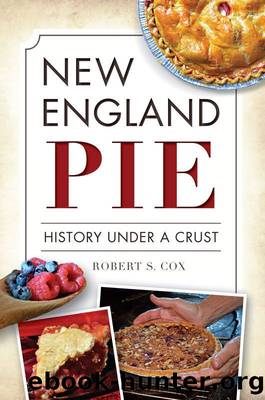New England Pie: History Under a Crust (American Palate) by Robert S. Cox

Author:Robert S. Cox [Cox, Robert S.]
Language: eng
Format: azw3
Publisher: Arcadia Publishing
Published: 2015-11-04T16:00:00+00:00
Boston Cream Pie
(First Congregational Society, Unitarian, Chelmsford, 1949)
Make two layers of hot milk cake and fill with your favorite filling.
Top with Richmond Chocolate Frosting.
½ cup sugar
1½ tbsp. cornstarch
1 ounce sq. chocolate (shaved)
pinch salt
½ cup boiling water
1½ tbsp. butter
½ tsp. vanilla
Mix sugar, cornstarch, chocolate, and salt. Add boiling water and cook until thick. Add butter and remove from stove and add vanilla. Cool.—Mrs. Lawrence A. Litchfield.
JULY
CHERRY ON THE DOORSTEP
The most ephemeral fruits of the year are delivered in the warmth of summer, when long sunlight bastes the world in perfection. New England favorites like raspberries, blackberries, whortleberries and gooseberries ripen to the clockwork, arriving in brief flurries as the days begin to shorten. The span is briefest for cherries. When our ancestors spoke of “cherry week” at the market, they meant it. Three weeks in June and July are near the upper limit for a harvest, and rains can make it shorter, or birds, when they are more diligent than the orchardist. Forget an apple for a week or two and it will cling, ripe or riper; forget a cherry and a crow steals it away.
Every pie in the New England calendar aspires to royalty, and a few attain it. Having thrown off the imperial yoke 250 years ago, we now revere pies instead of princes. We are a pie-loving culture, a stretch of the country where the love for savory meats coexists with the love for fruit. And among all the many varieties, cherry stands out as one of the most beloved. In tree as in pastry, it is loved for the grace of new green leaves and near-black bark, for an effusion of floral color in early spring and for the way the fruit delivers a helix of sweet and tart to the tongue. Each part played, each essential. When not cutting down mythical trees, George Washington was said to adore the cherry pie, more than almost any other, although the recipe for sweetbread pie that appears in Martha’s cookbook calls his fidelity into question. Regardless of what a wayward Virginian thought, for many in New England the sour cherry pie will always evoke the lush green heat of summer and the passing of an instant.
It may be surprising, then, that American cookbook authors show relatively little interest in the regal standard. Cherries were versatile enough to slip into cakes and puddings, and they made oceans of cherry water, wine and brandy, but as pies, they barely whisper. To be sure, this is a venerable pie. Culinary historians have noted that sweet fruit pies were sought after in the Renaissance and swelled in popularity during the reign of Queen Elizabeth, who was said to be partial to cherry pie. William Salmon’s recipe from 1710 is as good a representative as any of the ancient genre, slight on sugar and comparatively delicate in spice. Even when extravagant cookery was valued, cherry remained a simple pie, and Salmon did little to expand its boundaries. A half century later, Hannah Glasse had
Download
This site does not store any files on its server. We only index and link to content provided by other sites. Please contact the content providers to delete copyright contents if any and email us, we'll remove relevant links or contents immediately.
| Cajun & Creole | California |
| Hawaiian | Mid-Atlantic |
| Midwestern | New England |
| Northwestern | Soul Food |
| Southern | Southwestern |
| Western |
Biscuits: A Savor the South Cookbook by Belinda Ellis(3901)
Al Roker's Hassle-Free Holiday Cookbook by Al Roker(3175)
A Jewish Baker's Pastry Secrets: Recipes from a New York Baking Legend for Strudel, Stollen, Danishes, Puff Pastry, and More by George Greenstein(3100)
Ottolenghi Simple by Yotam Ottolenghi(3035)
Trullo by Tim Siadatan(2984)
The French Women Don't Get Fat Cookbook by Mireille Guiliano(2975)
Better Homes and Gardens New Cookbook by Better Homes & Gardens(2948)
Bake with Anna Olson by Anna Olson(2928)
Panini by Carlo Middione(2823)
Hot Thai Kitchen by Pailin Chongchitnant(2803)
Nigella Bites (Nigella Collection) by Nigella Lawson(2768)
Momofuku by David Chang(2761)
Modern French Pastry: Innovative Techniques, Tools and Design by Cheryl Wakerhauser(2722)
Salt, Fat, Acid, Heat: Mastering the Elements of Good Cooking by Nosrat Samin(2652)
Tapas Revolution by Omar Allibhoy(2532)
Classic by Mary Berry(2499)
Solo Food by Janneke Vreugdenhil(2489)
Best of Jane Grigson by Jane Grigson(2466)
Okonomiyaki: Japanese Comfort Food by Saito Yoshio(2387)
